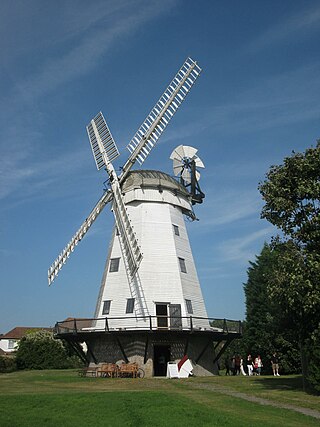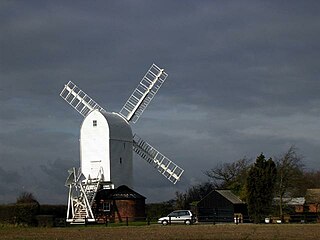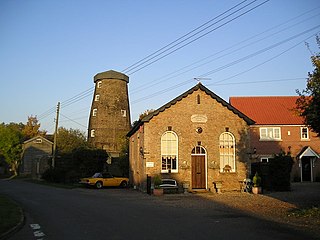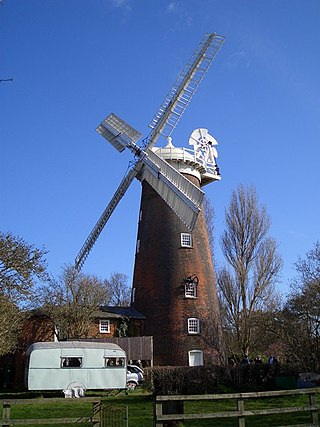
Upminster Windmill is a Grade II* listed smock mill located in Upminster in the London Borough of Havering, England. It was formerly known as Abraham's Mill and was in Essex when built. Between 2016 and 2023 the mill was restored to working order and a visitor centre was constructed. The mill and visitor centre are open to the public at selected times.

John Webb’s or Lowe’s Mill is a Grade II* listed tower mill at Thaxted, Essex, England, which had been restored to working order, but is currently out of action following the loss of a sail in April 2010.

Caston Tower Windmill is a grade II* listed tower mill at Caston, Norfolk, England which is under restoration. The mill is also a scheduled monument.

Shiremark Mill, also known as Kingsfold Mill or Capel Mill was a listed Smock mill at Capel, Surrey, England, which was burnt down in 1972.

Aythorpe Roding Windmill is a Grade II* listed Post mill at Aythorpe Roding, Essex, England which has been restored to working order.

Bocking Windmill or Bocking Churchstreet Windmill is a grade I listed post mill at Bocking, Essex, England which has been restored.

Ramsey Windmill is a grade II* listed post mill at Ramsey, Essex, England which has been restored.

Terling Windmill is a grade II listed Smock mill at Terling, Essex, England, which has been converted to residential use.

South Ockendon Windmill was a Smock mill at South Ockendon, Essex, England which collapsed on 2 November 1977.

Gibraltar Mill is a grade II listed Tower mill at Great Bardfield, Essex, England which has been converted to residential use.
Church End Mill is a grade II listed Tower mill at Great Dunmow, Essex, England which has been converted to residential use.

Stansted Mountfitchet Windmill is a grade II* listed Tower mill at Stansted Mountfitchet, Essex, England which is also a Scheduled Ancient Monument. It has been restored and can turn by wind.

Stock Windmill is a grade II* listed tower mill at Stock, Essex, which has been restored.

Upthorpe Mill is a Grade II* listed post mill and scheduled monument at Stanton, Suffolk, England, which has been restored to working order.

Thelnetham Windmill, also known as Button's Mill is a Grade II* listed tower mill constructed of brick. The windmill is located at Thelnetham, Suffolk, England. It was built in the early nineteenth century to grind wheat into flour. Thelnetham windmill worked by wind power until 1924, latterly on two sails, after which it became derelict.

Buxhall Mill is a tower mill at Buxhall, Suffolk, England which has been converted to residential accommodation.

Buttrum's Mill or Trott's Mill is a Grade II* listed tower mill at Woodbridge, Suffolk, England, which has been restored to working order.

Cromer Windmill, restored in four stages between 1967 and 1998, is a Grade II* listed post mill at Cromer, Ardeley, Hertfordshire, England.
Mill Lane Mill is a Grade II listed tower mill at Carbrooke, Norfolk, England which has been conserved with some machinery remaining.

Garboldisham Mill is a Grade II* listed post mill at Garboldisham, Norfolk, that has been restored.



















